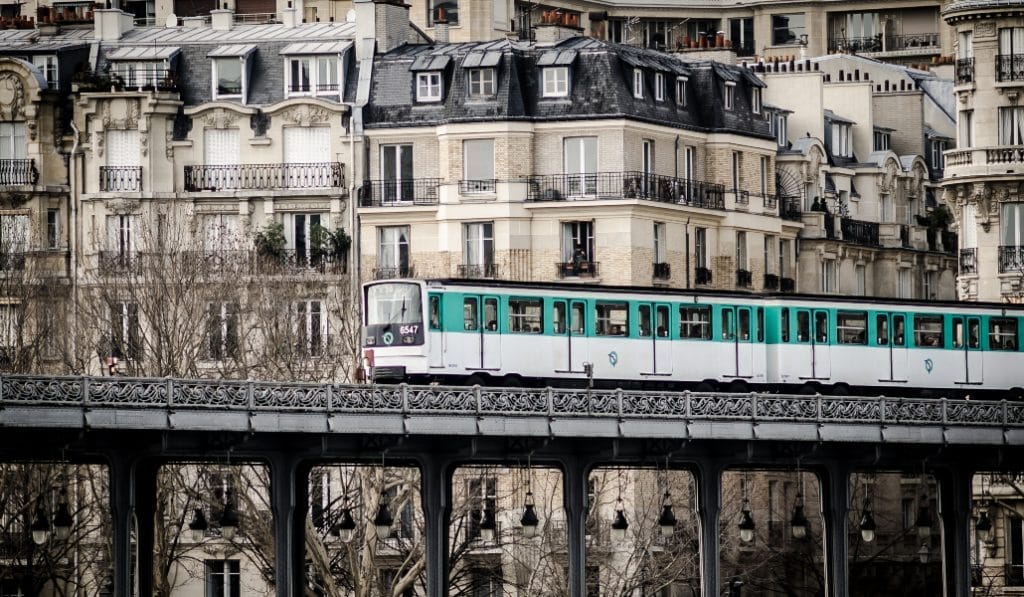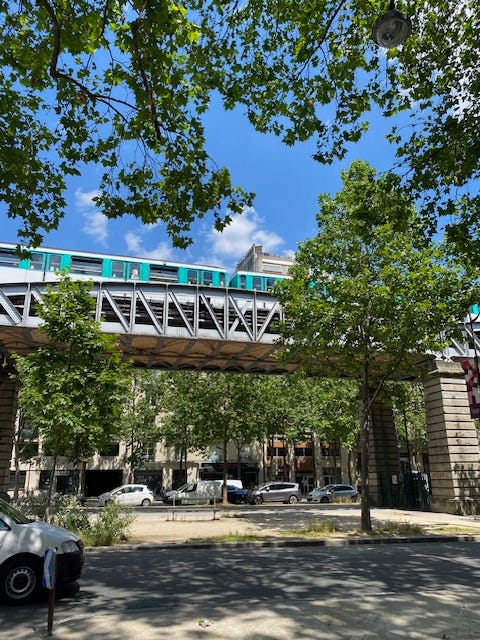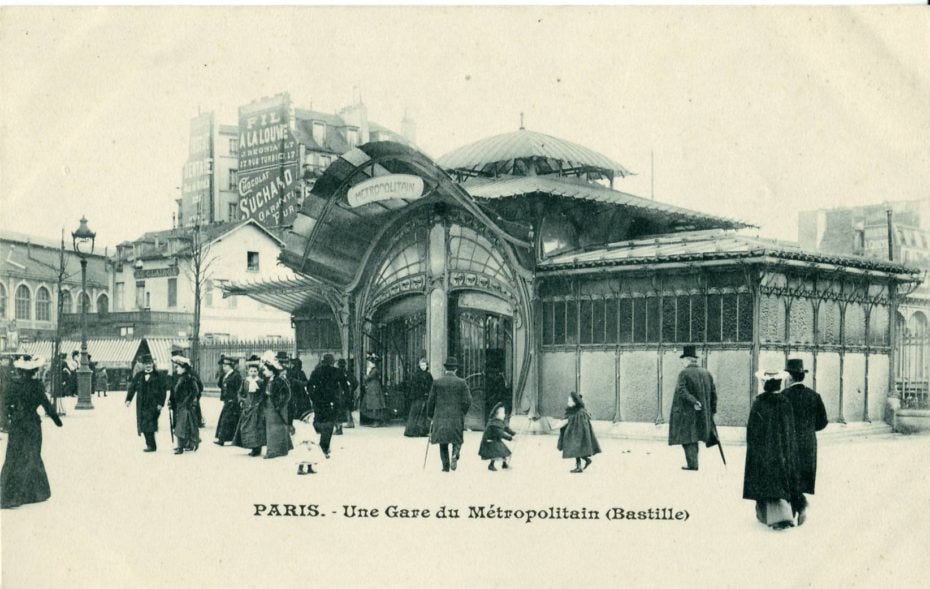Because of an Australian, le Bulletin 🇫🇷by Judy MacMahon, who loves all things French and writes a wonderful Substack, many of us who live and write about Paris and France have come to know and read each others’ Substacks. One of the newest writers I’ve learned about is Jenn Bragg who writes For The Love of France. Under her heading, she says “My life's work is observing the nuances of different cultures that you may not otherwise notice. I write mostly about French culture.”
I tend to write emotionally, how what I see and do hits me where I live. Jenn does her homework. When she writes about something that has caught her interest, she researches it and the reader, me, gets a history lesson about the city I love so much.
We all ride the metro almost every day (unless we can walk but recently it has been raining every day so the metro is it!!!). This week, Jenn wrote about the metro line #6 - one that goes from Etoile at the Arc de Triomphe in the 16th to Nation in the east of Paris, the 12th arrondissement. I’ve never thought about it much as I haven’t had to take it very often. I asked Jenn if I could share her wonderful writing with you:
One of my favorite Paris Metro lines
Line 6 delivers people to destinations and happiness to moi
OCT 06, 2024
How do I love thee, Paris metro line 6? Let me count the ways.
In Paris, each metro line has its own ‘vibe’, but Line 6 is one I really appreciate. It traverses the southern side of Paris, connecting Nation in the east to the Charles de Gaulle - Etoile station in the west, shown as a green line in the image below:
My favorite stretch of Line 6 is between Corvisart and Denfert-Rochereau. Those stops mostly cover above-ground views of Boulevard Saint-Jacques which turns into Boulevard Auguste Blanqui and ends at Denfert-Rochereau, known as the stop for the Paris catacombs.
I went out on Line 6 last week and recorded this video just to give you an idea of its loveliness:
Jenn’s video wouldn’t transfer so I encourage you to go to her Substack For The Love of France and watch it.
Now let’s just do a round-up of some of the interesting things about Line 6:
Open-air stations
Much of Line 6 features above-ground stations. When the track was built, it traced along an old city wall that was demolished in 1860. By building stations above ground, it reduced the need to dig tunnels for the trains. As a result, nearly half the 28 stations along Line 6 are raised platforms and feature glass canopy ceilings.
It’s old
The first iteration of Line 6 was completed in 1900. It was one of the main ways of reaching the area around the Eiffel Tower when Paris hosted the world’s fair that year. Later, more track and stations were added to expand the line so that it became the far-reaching, city-crossing stretch we know today.
Interesting WW2 history
Line 6 even has an interesting connection to the Second World War: a number of station names were used as code names for prominent members of the French Resistance. These code names were designated for several agents under the military leadership of General Charles de Gaulle to help with efforts against the Nazis to retake control of France.
Here are the code names that were assigned:
Passy - Andre Dewavrin was known as ‘Colonel Passy’ - he had a leading role in military intelligence and helped organize the French Resistance under the stewardship of Charles de Gaulle.
Saint-Jacques - the man who took this code name was Maurice Duclos, who also helped found the French Resistance. He created several Paris-based intelligence networks.
Corvisart - Alexandre Beresnikoff was born in Russia but was given the name by de Gaulle from his base in London to help with secret missions for the French Resistance.
Bienvenüe - this moniker was given to Ramond Lagier, who joined de Gaulle’s secret service in 1940.
Bir Hakeim Bridge
If you are heading west on Line 6, you will ride on top the Bir Hakeim Bridge - made famous by that horrible movie, Last Tango in Paris. I went there for the first time (!!) last December and it really is a gloriously beautiful bridge, with an unparalleled view of the Eiffel Tower. The best way to access the bridge is to get off at the Passy stop.
So, if you’re coming to Paris with an open agenda (the way I recommend to travel), grab line 6 and ride it through the southern side of Paris. If you go from one side to the other, you’ll see:
Great street art on the buildings in the eastern end of the line
The Eiffel Tower on the Western end of the line approaching Passy station, which is absolutely breathtaking
Gorgeous leafy neighborhoods between Corvisart and Denfeert-Rochereau
Yes, what I’m suggesting is that the next time you come to Paris, add ‘riding the metro’ as one of your activities. You won’t regret it!
Before I really leave you, in doing my research I stumbled on an old photo of this gorgeous Art Nouveau station at the Bastille metro stop. (Bastille is not on Line 6 but I love this pic so much, I’d be remiss not to share it.)
Beautiful, non?
Sources: Metro line 6: a line and its history | Culture (ratp.fr)
Discussion about this post
Comments
I watched the video, which I rarely do on Substack, and definitely recognized some of the buildings going by.
Something you might be interested in: when I was teaching high school French in the States, I used a book called "Le Monstre dans le Métro" for my second-year classes as a supplement to our textbook. I looked it up this evening, and it appears to have been written in 1977, which means it was quite modern when I started teaching in 1982. The action takes place on Line 6, and that is where I learned the names of many of the stations.
I later led two trips to France with students, and we rode line 6 the way you suggest, as an activity in and of itself. My students loved seeing the actual stations referred to in the book. I'm quite sure it contains a line something like "Corvisart! Glacière! Saint-Jacques! Le monstre se dirige vers la station Denfert-Rochereau!"
Such a gorgeous post! I haven’t been on the 6 for years and you’ve inspired me to take it just for the ride.
If you are interested in other Substacks about Paris and France, check out Judy’s FranceStack. She has listed each of us who wish to be included in her list of Substack’s on all the many wonderful aspects of France. “Savvy Francophiles read 'le Bulletin' newsletter: a luscious immersive weekend of Francophilia, including recently published articles from MyFrenchLife.org by me, Judy MacMahon, Fondatrice, MyFrenchLife™ Magazine”
A bientôt,
Sara












Nice - thanks! Opened my eyes to line 6! As for that Bir Hakeim bridge, I've seen people getting married in it or simply taking wedding photos because of the incredible view of the Eiffel Tower in the background.
Sara, thank you so much for your very kind review of my work. I’m honored to be able to share this platform (and a love of France) with you and Judy and all the others who write about France! 🇫🇷